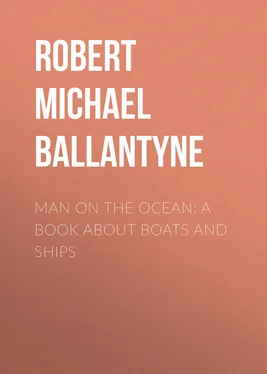Robert Michael Ballantyne - Man on the Ocean - A Book about Boats and Ships
Здесь есть возможность читать онлайн «Robert Michael Ballantyne - Man on the Ocean - A Book about Boats and Ships» — ознакомительный отрывок электронной книги совершенно бесплатно, а после прочтения отрывка купить полную версию. В некоторых случаях можно слушать аудио, скачать через торрент в формате fb2 и присутствует краткое содержание. Жанр: foreign_desc, Технические науки, на английском языке. Описание произведения, (предисловие) а так же отзывы посетителей доступны на портале библиотеки ЛибКат.
- Название:Man on the Ocean: A Book about Boats and Ships
- Автор:
- Жанр:
- Год:неизвестен
- ISBN:нет данных
- Рейтинг книги:5 / 5. Голосов: 1
-
Избранное:Добавить в избранное
- Отзывы:
-
Ваша оценка:
- 100
- 1
- 2
- 3
- 4
- 5
Man on the Ocean: A Book about Boats and Ships: краткое содержание, описание и аннотация
Предлагаем к чтению аннотацию, описание, краткое содержание или предисловие (зависит от того, что написал сам автор книги «Man on the Ocean: A Book about Boats and Ships»). Если вы не нашли необходимую информацию о книге — напишите в комментариях, мы постараемся отыскать её.
Man on the Ocean: A Book about Boats and Ships — читать онлайн ознакомительный отрывок
Ниже представлен текст книги, разбитый по страницам. Система сохранения места последней прочитанной страницы, позволяет с удобством читать онлайн бесплатно книгу «Man on the Ocean: A Book about Boats and Ships», без необходимости каждый раз заново искать на чём Вы остановились. Поставьте закладку, и сможете в любой момент перейти на страницу, на которой закончили чтение.
Интервал:
Закладка:
So much for “boxing the compass.” The manner in which it is used on board ship, and the various instruments employed in connection with it in the working of a vessel at sea, will be explained shortly; but first let us glance at the history of the compass.
It is a matter of great uncertainty when, where, and by whom the mariner’s compass was invented. Flavio Gioia, a Neapolitan captain or pilot, who lived about the beginning of the fourteenth century, was generally recognised throughout Europe as the inventor of this useful instrument; but time and research have thrown new light on this subject. Probably the Neapolitan pilot was the first who brought the compass into general notice in Europe; but long before 1303 (the year in which it was said to have been invented) the use of the magnetic needle was known to the Chinese.
Loadstone , that mineral which has the mysterious power of attracting iron, and also of imparting to iron its own attractive power, was known to the Chinese before the year 121, in which year a famous Chinese dictionary was completed, wherein the word magnet is defined as “the name of a stone which gives direction to a needle.” This proves not only that they knew the attractive properties of the loadstone, and its power of imparting these properties to metal, but also that they were aware of the polarity of a magnetised needle. Another Chinese dictionary, published between the third and fourth centuries, speaks of ships being guided in their course to the south by means of the magnet; and in a medical work published in China in 1112, mention is made of the variation of the needle, showing that the Chinese had not only used the needle as a guide at sea, but had observed this one of its well-known peculiarities—namely, the tendency of the needle to point in a very slight degree away from the true north.
In the thirteenth century, too, we find mention made of the needle by a poet and by two other writers; so that whatever Flavio Gioia may have done (and it is probable he did much) in the way of pushing the compass into notice in Europe, he cannot be said to be the inventor of it. That honour doubtless belongs to the Chinese. Be this as it may, the compass was invented; and in the fourteenth century it began that revolution in maritime affairs to which we have alluded.
The first compasses were curiously formed. The Chinese used a magnetised needle, which they placed in a bit of rush or pith, which was floated in a basin of water, and thus allowed to move freely and turn towards the poles. They also made needles in the form of iron fish. An Arabian author of the thirteenth century thus writes:– “I heard it said that the captains in the Indian seas substitute for the needle and reed a hollow iron fish magnetised, so that, when placed in the water, it points to the north with its head and to the south with its tail. The reason that the iron fish does not sink, is that metallic bodies, even the heaviest, float when hollow and when they displace a quantity of water greater than their own weight.”
The use of the compass at sea is so simple, that, after what has been said, it scarcely requires explanation. When a ship sets sail for any port, she knows, first of all, the position of the port from which she sets sail, as well as that to which she is bound. A straight line drawn from the one to the other is her true course, supposing that there is deep, unobstructed water all the way; and if the compass be placed upon that line, the point of the compass through which it passes is the point by which she ought to steer. Suppose that her course ran through the east point of the compass: the ship’s head would at once be turned in that direction, and she would continue her voyage with the needle of the compass pointing straight across the deck, and the east and west points straight along it.
But various causes arise in the actual practice of navigation to prevent a ship keeping her true course. Winds may be contrary, and currents may drive her either to the one side or the other of it; while land—promontories, islands, and shallows—compel her to deviate from the direct line. A vessel also makes what is called “leeway;” which means that, when the wind blows on her side, she not only advances forward, but also slides through the water sidewise. Thus, in the course of a day, she may get a considerable distance off her true course—in sea parlance, “make a good deal of leeway.”
To perform the voyage correctly and safely in the face of these obstacles and hindrances is the aim and end of navigation; and the manner of proceeding is as follows:—
The hour is carefully noted on setting sail, and from that moment, night and day, to the end of the voyage, certain observations are made and entered in the ship’s journal, called the log. Every hour the rate at which the ship is going is ascertained and carefully noted. The point of the compass towards which the ship is to be steered is given by the captain or officer in command to the steersman, who stands at the wheel with a compass always before him in a box called the “ binnacle .” The course is never changed except by distinct orders from those in command; and when it is changed, the hour when the change is made and the new course to be steered are carefully noted down. Thus, at the end of the day, or at any other time if desired, the position of the ship can be ascertained by her course being drawn upon a chart of the ocean over which she is sailing,—correct charts, or maps, being provided by the captain before starting.
The estimate thus made is, however, not absolutely correct. It is called the “ dead-reckoning ,” and is only an approximation to the truth, because allowance has to be made for leeway, which can only be guessed at. Allowance has also to be made for variations in the rate of sailing in each hour, for the winds do not always blow with exactly the same force during any hour of the day. On the contrary, they may vary several times within an hour, both in force and in direction. Those variations have to be watched and allowed for; but such allowance may be erroneous in a greater or less degree. Currents, too, may have exerted an unseen influence on the ship, thus rendering the calculation still less correct. Nevertheless, dead-reckoning is often the only guide the sailor has to depend upon for days at a time, when storms and cloudy skies prevent him from ascertaining his true position by other means, of which we shall speak presently.
Of course, in the early days of navigation there were no charts of the ocean. The navigator knew not whither he was hurrying over the wild waste of waters; but by observing the relative position of some of the fixed stars to his course while sailing out to sea, he could form a rough idea of the proper course to steer in order to return to the port whence he had started.
The compass, then, shows the sailor the course he has been going, and the log (of which more presently) enables him to ascertain the rate at which he has proceeded; while his chronometers, or time-keepers, tell him the time during which the course and rate of sailing have been kept up. And many a long cruise on the unknown deep has been successfully accomplished in days of old by bold seamen, with this method of dead-reckoning; and many a mariner at the present day depends almost entirely on it, while all are, during thick, stormy weather, dependent on it for days and sometimes weeks together.
The log , to which we have referred, is the instrument by which is determined the rate at which a ship is progressing. It is a very simple contrivance: a triangular piece of wood about the size of a large saucer, with a piece of stout cord fastened to each corner, the ends of the cords being tied together, so that when held up, the “log,” as it is called, resembles one of a pair of scales. One of the cords, however, is only temporarily attached to its corner by means of a peg, which when violently pulled comes out. One edge of the triangle is loaded with lead. The whole machine is fastened to the “log-line,”—a stout cord many fathoms long, which is wound on a large reel.
Читать дальшеИнтервал:
Закладка:
Похожие книги на «Man on the Ocean: A Book about Boats and Ships»
Представляем Вашему вниманию похожие книги на «Man on the Ocean: A Book about Boats and Ships» списком для выбора. Мы отобрали схожую по названию и смыслу литературу в надежде предоставить читателям больше вариантов отыскать новые, интересные, ещё непрочитанные произведения.
Обсуждение, отзывы о книге «Man on the Ocean: A Book about Boats and Ships» и просто собственные мнения читателей. Оставьте ваши комментарии, напишите, что Вы думаете о произведении, его смысле или главных героях. Укажите что конкретно понравилось, а что нет, и почему Вы так считаете.












